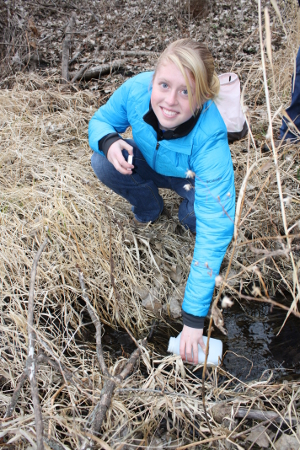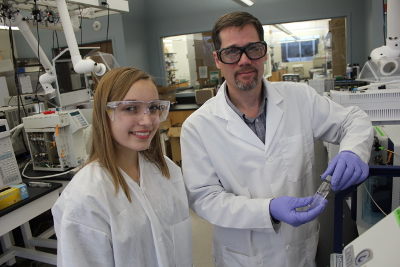
| March 2013 | |||||||||||
| Top stories | |||||||||||
| In the news | |||||||||||
| Photos | |||||||||||
| Contact us | |||||||||||
| Archive | |||||||||||
|
Students tackle milk safety, water and alternative fuel |
The safety of milk sold in developing nations, water quality in West Lake Okoboji, and grass as an alternative fuel source are topics of study for this year's recipients of the State Hygienic Laboratory's Student Mentorship award.
The Student Mentorship Program teams laboratory scientists with junior high and high school students who need lab assistance in completing a science project. Through previous mentorship projects, students measured levels of estrogen and other pharmaceuticals in ground water, tested for pesticides in plant roots, and assessed the amount of bacteria on toothbrushes.
This year's recipients worked with Hygienic Lab staff in Coralville, Ankeny and Lakeside Lab to complete projects that may benefit people in Iowa and around the world. The program also was supported by the Iowa local section of the American Chemical Society and the Friends of Lakeside Laboratory.
A safe system to remove dangerous adulterants
Ankita Chatterjee, an eighth-grader at Callanan Middle School, Des Moines, hopes to improve the safety of milk in developing nations where contamination from chlorine, iron and pesticides is a common problem.

Ankita Chatterjee with mentor Megan Mekoli, Ph.D.
The Food Safety and Standards Authority of India reported last year that more than two-thirds of milk in the country was adulterated by a variety of substances, including detergents.
Last year, Chatterjee designed a simple method to detect contaminants in milk. She applied to the Student Mentorship program for laboratory support to expand her method to include detection of melamine.
Melamine is an organic compound, used to create fire-resistant materials, that is sometimes used illegally to falsely elevate protein content in foods. In 2008, melamine-tainted infant milk sickened thousands of babies and spurred a World Health Organization investigation.
"I would like to experiment with various substances that could either filter or absorb the majority of these contaminants," Chatterjee said in her Student Mentorship application. "My ultimate goal is to create a low-cost, effective, and safe system to remove dangerous adulterants, including melamine, which could be utilized in developing countries."
Chatterjee's lead mentor is Megan Mekoli, Ph.D.
Preserving the pristine water of a rare lake

Lauren Schwark
Lauren Schwark is part of a new tradition in Milford, Iowa. The junior at Spencer High School is the fifth student in nearly four years to contribute to a better understanding of three sub-watersheds that drain into the pristine waters of West Lake Okoboji. All five students were recipients of the Hygienic Laboratory's Student Mentorship award.
West Lake Okoboji near Milford, Iowa, was formed more than 13,000 years ago when the last glacier to cover northern Iowa receded. It left behind the deepest natural lake in Iowa with an estimated maximum depth of 134 feet.
Today it is one of the few Iowa lakes designated by the Iowa Department of Natural Resources as an Outstanding Iowa Waters because of its "substantial recreational or ecological significance."
Under the guidance of the Hygienic Laboratory's Dennis Heimdal and her teacher Chris Oponski, Schwark is collecting water samples from the sub-watersheds from October 2012 through April 2013. Heimdal, an environmental lab specialist, helps Schwark test the samples at the Iowa Lakeside Lab in Milford. The results are added to the catalog of data gathered by Schwark's predecessors, providing a brief history of water quality around Lakeside Lab.
"This project is important to me because this has given me the opportunity to see what a real chemist does in the field," Schwark said. "This could impact others by giving information about their surroundings and make them more informed."
A sub-watershed is a small area of land that water passes through on its way to a river, lake or other waterway. Sub-watersheds that show good land use practices are essential to preserving water quality because they can act as a filter to catch sediment, phosphorus and other contaminants before they reach the waterway.
"Lauren will analyze the samples for nitrate and phosphorus concentrations, turbidity, pH, and temperature," Heimdal said. "She will also compare her results with the past three years' worth of data. This data may be used for determining nutrient loading into West Okoboji Lake."
From grass to gas
The Earth's climate is changing, due in large measure - according to the Environmental Protection Agency - to excessive amounts of carbon dioxide and other heat-trapping gases created by human activities, such as driving, generating electricity and deforestation.
Abby Walling looked into her backyard for an alternative fuel source and created an experiment that received Student Mentorship support.

Abby Walling with mentor Terry Cain
The Iowa City West High School sophomore collected grass clippings and put them through a fermentation process to demonstrate how grass can be turned into cellulosic ethanol.
Cellulosic ethanol can create three times more energy than conventional ethanol and can be processed with far lower emissions, according to a report by Dan Burden, of the Iowa State University Agricultural Marketing Resource Center. Cellulosic ethanol can be created from the unused stalks of corn and sugarcane, and from some industrial waste, such as sawdust and paper pulp.
Walling's project demonstrates that, through a process of catalyzation and fermentation, Kentucky bluegrass has the potential to create cellulosic ethanol.
"This is significant because in the future, people could mow their lawn, place their grass clippings in a large container with water, add cellulase, inoculate with concentrated Cedecea davisae, and let the mixture ferment for a week," Walling said in her report. "After the grass was allowed to ferment, a distillation company could distill everybody's mixture into pure ethanol. Done on a large scale, this will help to counteract some of the world's problems."
Walling's alternative fuel project was selected as a Student Mentoring project for the first time in the 2011-2012 school year. She received this year's award to continue her work. Terry Cain, environmental lab supervisor, is Walling's mentor.
Walling received a Young Naturalist Award from the American Museum of Natural History (AMNH) for a paper that chronicles her experiment. In May, her project will compete in the Junior Science and Humanities Symposium with projects from 99 other student scientists from across the country.
In 2011, Walling received an AMNH award for a previous Student Mentorship project that compared bacteria in the mouths of humans and dogs. Gabe Gerken, clinical lab technical specialist, was Walling's mentor for that project.